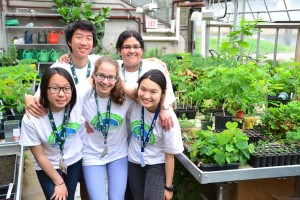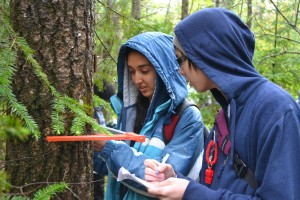Training Tomorrows’ Green Leaders

Originally appears in the Winter 2015 issue
I remember the first day I experienced an Envirothon. As students started to gather for our Provincial Championship, I didn’t know what to expect. As I listened to their conversations, I heard them describe the ways their schools were reducing their environmental impact. Several mentioned that they were applying for post-secondary environmental and science programs because of the cool jobs they learned about through the Envirothon process. It was over the next few days that I really began to appreciate the value that a program like this had for high school students. Learning first hand of career opportunities and having the chance to ask questions of those working in the field of natural resources was having a huge influence on the career path of students. Not only that, but the program gave students a chance to interact with other like-minded youth who were genuinely interested in the sustainability of our planet.
For many students who do not participate in sports, the Envirothon provides an opportunity to be part of a team. They work with their teammates to answer tough questions and come up with solutions to challenging environmental problems. Across North America, this program is helping to build the green leaders of tomorrow.
What is Envirothon?
The North American Envirothon is a network of states, provinces, and territories that run environmental education events throughout the year. The events include workshops that get teams of students outdoors learning about the environment through interactive experiences and the opportunity to engage with professionals working in the field. Each Envirothon team is composed of five students who are in grades 9 through 12. Every year, students learn about four key topics: soils, forestry, wildlife and aquatics. In addition, a fifth topic area is added in consultation with all the partners across North America. In 2015 for example, the additional topic will be Urban and Community Forestry.
Following workshops, teams are tested at a competition on their knowledge through written tests which challenge the students to demonstrate their newfound knowledge. Depending on the jurisdiction, some may have one large competition, while others have multiple regional competitions that lead to a larger championship. The winner of each state and provincial competition then competes at the North American-wide championship.
Some of the activities that Envirothon students participate in include:
- identifying a tree species and measuring its height with the provided tools
- analyzing and labeling the soil profile shown in a soil pit
- describing the steps your team would take to manage an invasive species such as garlic mustard
- collecting and identifying Benthic Macroinvertebrates (BMI). What does the presence or absence of different species of BMI indicate about the health of the aquatic ecosystem?
 In addition to the written test component, students also participate in a presentation component. The team of students is challenged to develop a solution to a community environmental issue and deliver the solution to a panel of judges. The goal is for the students to combine all of their new knowledge and use this to create new solutions, and concisely communicate this to a group of resource professionals. They are given a limited amount of time (anywhere from one hour to several) and materials (Bristol board, markers, paper, pencils), and must put together a concise presentation that provides some solutions to the challenge. Through this component we really see the students shine. Not only do they develop new ideas, but their teamwork, communication and problem solving skills are tested and proven. Judging panels can include resource professionals, politicians, consultants, and government employees and the solutions that are presented often impress these working professionals.
In addition to the written test component, students also participate in a presentation component. The team of students is challenged to develop a solution to a community environmental issue and deliver the solution to a panel of judges. The goal is for the students to combine all of their new knowledge and use this to create new solutions, and concisely communicate this to a group of resource professionals. They are given a limited amount of time (anywhere from one hour to several) and materials (Bristol board, markers, paper, pencils), and must put together a concise presentation that provides some solutions to the challenge. Through this component we really see the students shine. Not only do they develop new ideas, but their teamwork, communication and problem solving skills are tested and proven. Judging panels can include resource professionals, politicians, consultants, and government employees and the solutions that are presented often impress these working professionals.
The champion of each Envirothon program is a culmination of the different marks received in testing and the presentations, with each region sending their top team to the North American Envirothon that happens annually in the summer. (The 2015 North American Envirothon takes place in July in Springfield, Missouri. The 2016 competition takes place in July at Trent University in Peterborough, Ontario.)
Why participate?
Since 1975, the Envirothon program has reached hundreds of thousands of students across North America and has challenged high school students to explore basic science concepts, increase their awareness of natural systems and explore natural resource career options with professionals employed in the field. In addition, the Envirothon program develops important critical thinking, problem solving, teamwork and communications skills in participants.
Teachers see the Envirothon program as a way to celebrate and encourage students’ interest in the environment and as an opportunity to build fundamental skills. Envirothon alumni have identified the program as a formative experience which resulted in their decision to pursue schooling and careers in the natural resources sector. The program provides a unique opportunity for students to be a part of a larger network that celebrates youth interest in the environment and to experience new ideas, perspectives, and cultures throughout North America.
Perhaps most importantly, the Envirothon is a unique and valuable program because it puts sustainability in the minds of today’s youth. Participating in the program enables youth to be more confident, knowledgeable, articulate, and collaborative – skills that are vital in making a sustainable future a reality. The Envirothon program is playing a major role in building tomorrow’s green leaders.
How to get involved?
Steps:
- If you are interested in learning more about an Envirothon program in your province, state or territory visit envirothon.org to find your coordinator’s contact information.
- Contact your local coordinator to register for the competition and get access to learning resources.
- Bring Envirothon learning resources into your classroom and get your whole class engaged in learning about soils, wildlife, aquatics, and forestry.
- Select a 5-student team to represent your school. This team may stem from your science or environment class, or may even be a part of your school’s green team. (Note in some regions, more than one team per school is permitted).
- Help prepare the team with learning resources and by attending local Envirothon workshops.
- Bring your team to the competition day, and watch your team take on other schools for a chance to win the championship title!
To view the photo-rich magazine version, click here.
Jessica Kaknevicius is the Education Programs Manager at Forests Ontario, a non-proft organization committed
to the regreening of Ontario through tree planting, and the renewal and stewardship of Ontario’s forests. The Ontario Envirothon is a program of Forests Ontario and in 2014 celebrated its’ 20th year. Regional competitions are held every year in Ontario in April, with the provincial Championship taking place in May.
Leave a Reply
You must be logged in to post a comment.





